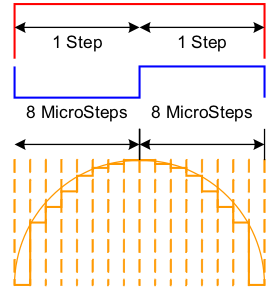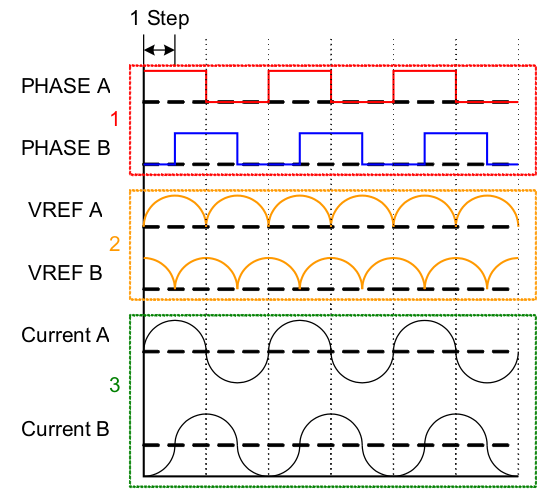SLVA416A September 2010 – September 2021 DRV8424 , DRV8812 , DRV8813 , DRV8818
2.2 The Micro Step
If full steps are all that the application requires, then Figure 2-1 is the optimal solution. However, the great majority of applications can certainly benefit from dividing full steps into smaller steps.
Figure 2-2 shows two full steps on the top and a way to divide each full step into 8 smaller steps. We have chosen a sine wave shape, although in reality this waveform can have any shape the users chooses. The idea behind microsteps is to make the current flowing through the winding different than FULL ON on one direction and FULL ON on the opposite direction. This allows for the rotor to be pushed/pulled in increments rather than full force.
 Figure 2-2 Micro Step
Figure 2-2 Micro StepBecause the DC motor driver has the capability to regulate winding current, and said current is directly proportional to the VREF input, it is possible to embed the prospective waveform at the current side. Figure 2-3 shows the result of embedding said waveform into the winding current, which is the concept behind this application note.
 Figure 2-3 Embedded Waveform Into Winding Current
Figure 2-3 Embedded Waveform Into Winding CurrentA microcontroller, such as the MSP430F1612 and utilizing GPIO outputs, will drive the motor driver’s PHASE inputs in the alternating fashion we saw on previous figures. However, and at the same time, the VREF pins will be modulated by using the two DAC outputs to superimpose a sine wave crest.
As a result, the motor windings see a full sine wave of current being applied to them. Because the current is segmented in smaller steps, the rotor also moves in smaller steps.